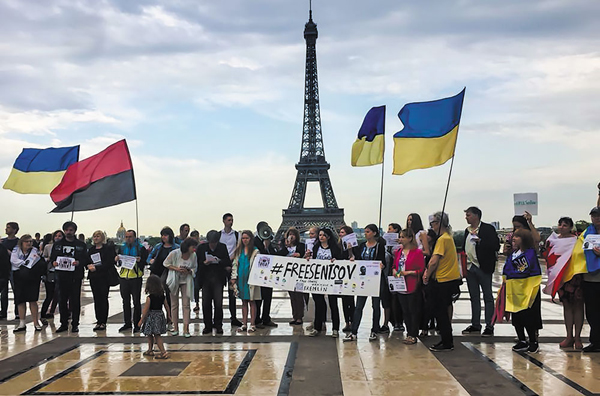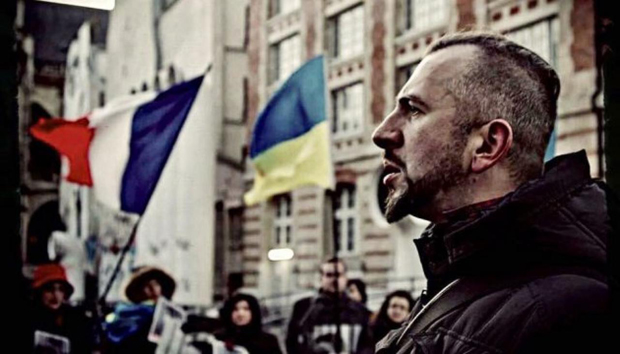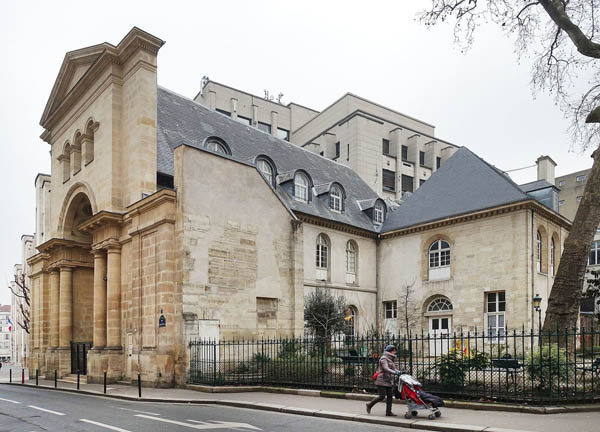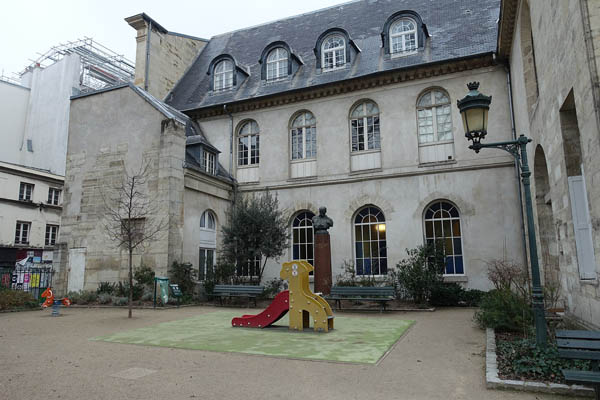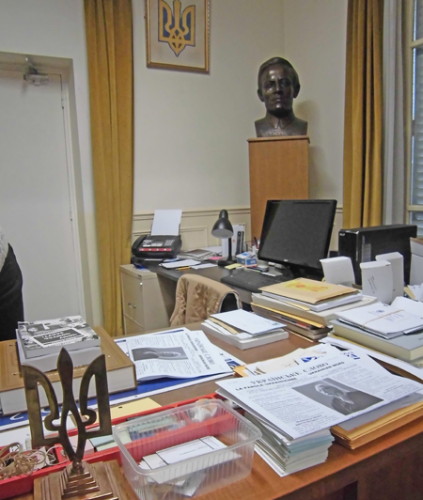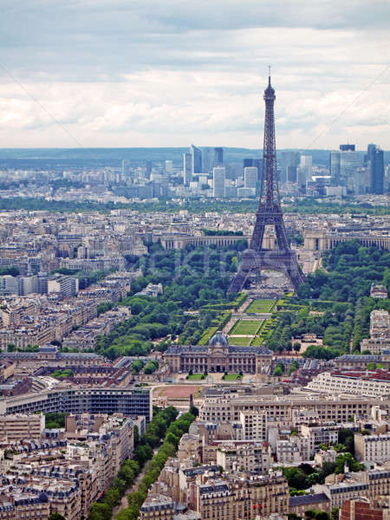Paris
Paris. See Map. The capital of France and one of the world’s political, cultural, and economic centers (2020 pop 2,148,271; metropolitan area, 12,532,901). Paris is one of the destinations of migrants of all countries, and small groups of Ukrainians have resided there since the Middle Ages. It is estimated that in the 20th century between 600 and 1,200 have lived in Paris at any given time.
The first mention of Ukrainians in Paris dates from the mid-11th century, with the marriage of Anna Yaroslavna to Henry I. In the 14th and, increasingly, through the 15th to 17th centuries Ukrainians began arriving in the city to study at the Sorbonne. Some manuscripts written by these students have survived, including the Hrammatyka slovenskaia/Grammatica sclavonica (Slavonic Grammar, 1643, 1645) of Ivan Uzhevych.
The first Ukrainian political émigrés in Paris were Hryhor Orlyk and the supporters of Hetman Ivan Mazepa who followed him. In 1765 Hetman Kyrylo Rozumovsky visited Paris and was received at the royal court. In 1761–5 the painter Antin Losenko studied in Paris. In the late 19th century a number of Ukrainian cultural figures lived in the city, including Marko Vovchok (1860–7), Mariia Bashkirtseva (1860–4), and Fedir Vovk (who studied and worked in the school of anthropology in Paris in 1887–1900). Mykhailo Drahomanov visited Paris in the 1870s and 1890s and took part in an international literary congress in Paris in 1878. In 1903 Mykhailo Hrushevsky stayed in Paris and taught at the Russian higher school of social sciences.
There was no organized Ukrainian presence in Paris until the 20th century, when the Circle of Ukrainians in Paris became active in 1908–14. Its membership (120) consisted largely of post-1905 emigrants from Russian-ruled Ukraine and Galician students, and it issued a number of French-language publications about Ukraine. The initiator and head of the circle was Yaroslav Fedorchuk.
After the First World War, Ukrainian members of the expeditionary corps of the Russian army as well as a number of diplomatic delegations of the Ukrainian National Republic and the Western Ukrainian National Republic arrived to take part in the Paris Peace Conference. The Ukrainian delegations established a press bureau (see Press and information bureaus abroad) and published the Bulletin d'informations (edited by Fedir Savchenko).
Paris became an important Ukrainian center in the interwar period, as its community grew with an influx of economic immigrants from Western Ukraine (particularly Galicia) in 1923. The following year political émigrés started arriving, among them Ilarion Kosenko, Symon Petliura, Viacheslav Prokopovych, Oleksander Shulhyn, Mykola Shumytsky, former officers and soldiers of the Army of the Ukrainian National Republic (Mykola Kapustiansky, Mykola Yu. Shapoval, Oleksander Udovychenko, and others), and members of Oleksander Koshyts’s Ukrainian Republican Kapelle (O. Chekhivsky, K. Mykolaichuk). Volodymyr Vynnychenko lived in Paris for a time, in the 1930s, as did Mykola Stsiborsky and Volodymyr Martynets. The major Ukrainian organizations of the period were centered in Paris and included the Ukrainian Hromada in France (1924–76), the Ukrainian National Union in France (1932–44), the Union of Ukrainian Emigré Organizations in France (1925–40), the Society of Former Combatants of the Ukrainian Republican Democratic Army in France (est 1927), the Union of Ukrainian Citizens in France (1925–32), the Ukrainian Students’ Hromada (est 1924), and the Petliura Ukrainian Library (est 1929). Paris was also the site of Petliura’s assassination in 1926 and the subsequent Schwartzbard Trial.
Eight Ukrainian periodicals were published in Paris during the interwar period, including Tryzub (1925–40), Ukraïns’ke slovo (Paris) (est 1933), Vistnyk Ukraïns’koï Hromady u Frantsiï (1929–38), Ukraïns’ki visty (1926–9), Prométhée (1926–38, in French), and La Revue de Prométhée (1938–40, in French).
During the German occupation, most Ukrainian organizations halted their activities. Only the Ukrainian Institution of Trust (headed by Ivan Stasiv), which oversaw the general social and cultural welfare of Ukrainian émigrés and refugees in 1942–4, was officially sanctioned. The Kobzar publishing house was also active. Some Ukrainians in Paris were arrested, including Oleksander Boikiv, Elie Borschak, Mykola Yu. Shapoval, and Oleksander Shulhyn.
More Ukrainian immigrants to Paris arrived at the end of the Second World War from the displaced persons camps in Germany and Austria. A number of prewar organizations resumed their activities during this period, including the Ukrainian National Union in France (reconstituted as the Ukrainian National Alliance in France in 1949), the Society of Former Combatants of the Ukrainian Republican Democratic Army in France, and the Ukrainian Students’ Hromada. New organizations were also established, including the Union of Ukrainian Workers in France (1945), the Union of Ukrainians of France (1948), Ukrainian Community Aid in France (est 1946), the Ukrainian Academic Society in Paris (1946), the Ukrainian Christian Movement (1955), the Ukrainian Women's Association of France (1945), the Ukrainian Youth Association (1949), and the Organization of Ukrainian Youth in France (1956). In 1951–4 the headquarters of the Central Union of Ukrainian Students was located in Paris. The Ukrainian Central Civic Committee in France, an umbrella organization established in 1948, co-ordinated the activities of all of these groups. In 1985 the Ukrainian Central Representation in France was formed as a rival umbrella group.
Postwar periodicals included Ukraïns’ke slovo (Paris) (re-established in 1948), Ukraïnets’-Chas (originally, Ukraïnets’ u Frantsiï, 1945–60), Hromada (1948–9), Soborna Ukraïna (1950–1), and Ukraïna (1949–53). Six journals were published in French: ABN Correspondance (1952–4; see ABN Correspondence), L’Ukraine libre (1954–5), Bulletin franco-ukrainien (1958–70), L’Est européen (1962–99), Echos d’Ukraine (1962–9), and Échanges: Revue franco-ukrainienne (1971–88). Only the weekly Ukraïns’ke slovo has continued publishing to this day.
There are two Ukrainian churches in Paris. The Orthodox one was consecrated in 1925; it was presided over by Metropolitan Polikarp Sikorsky in 1949–53. The Catholic church was consecrated in 1937; it served as the seat for Bishop Volodymyr Malanchuk in 1961–83 and was the seat of Bishop Michael Hrynchyshyn after 1983.
Paris is an important center of Ukrainian academic life. The Shevchenko Scientific Society (NTSh) in Europe had its headquarters and a major library in the nearby suburb of Sarcelles. The Petliura Ukrainian Library contains a valuable library, museum, and archives. Interest in Ukrainian scholarship was fostered by the Franco-Ukrainian Cercle des Études Ukrainiennes (est 1930). The Institut National des Langues et Civilisations Orientales has had Ukrainian language and culture as part of its curriculum since 1939. Elie Borschak (1939–59), Marie Scherrer (1959–72), E. Kruba (1972–99), and O. Mandzukova-Camel have been language instructors; Arkadii Zhukovsky taught Ukrainian cultural history (1960–88). The Institut d’Études Slaves, the Institut National des Langues et Civilisations Orientales, the Bibliothèque de Documentation Internationale Contemporaine à Nanterre, the Bibliothèque Nationale, and the Bibliothèque Slave also have substantial collections of Ukrainian materials.
The following are some of the artists who have been active in Paris: Mykhailo Andriienko-Nechytailo, Alexander Archipenko, Mariia Bashkirtseva, Mykhailo Boichuk, Severyn Borachok, Alexandra Exter, Jacques Hnizdovsky, Mykola Hlushchenko, Sviatoslav Hordynsky, Oleksa Hryshchenko, Liuboslav Hutsaliuk, Vasyl Khmeliuk, Mykola Krychevsky, Petro Levchenko, Sofiia Levytska, Myron Levytsky, Antin Losenko, Volodymyr Makarenko, Omelian Mazuryk, Oleksander Murashko, Petro Omelchenko, Vasyl Perebyinis, O. Savchenko-Bilsky, Andrii Solohub, Anton Solomukha, Mykhailo S. Tkachenko, Temistokl Vyrsta, and Sofiia Zarytska. Among the many Ukrainian composers and musicians who resided in Paris have been D. Drohomyretska, Volodymyr Hrudyn, Marian Kouzan, Yu. Ponomarenko, Ivan Vovk, Arystyd Vyrsta, Fedir Yakymenko, and the singers U. Chaikivska, Myroslav Starytsky, and Yevheniia Zarytska. Serge Lifar rose to prominence as the premier ballet dancer and choreographer of Paris Opera Ballet. Theater productions were staged in the city by amateur groups sponsored by the Ukrainian Hromada in France in 1925–32 and in the 1950s under the direction of Nataliia Pylypenko.
Paris is an important international political center. Parisian Ukrainians have been active in the Friendship Committee of Peoples of the Caucasus, Turkestan, and Ukraine; the Anti-Bolshevik Bloc of Nations; the Paris Bloc; and the International Free Academy of Arts and Sciences. The dissident mathematician and thinker Leonid Pliushch resided near Paris after his release from the Soviet Union in 1976 and frequently championed human rights and Ukraine’s cause in the international arena. The United Nations Educational, Scientific, and Cultural Organization (UNESCO), which has its headquarters in Paris, has occasionally been the site of international exhibitions sponsored by the Ukrainian SSR and independent Ukraine.
A bust of Taras Shevchenko (donated by Soviet authorities) stands in Taras Shevchenko Square near the Ukrainian Catholic church. In the church of Saint-Germain-des-Prés there is a bas-relief depiction of the Battle of Berestechko between the Ukrainians and the Poles that took place during the Cossack Polish War. Symon Petliura lies buried in the Montparnasse cemetery, and the graves of Metropolitan Polikarp Sikorsky, Gen Mykhailo Omelianovych-Pavlenko, and Nestor Makhno are in the Père-Lachaise cemetery. (See also France.)
BIBLIOGRAPHY
Lazovins'kyi, V. Paryzh (Providnyk) (Paris 1973)
De Ponfilly, R. Guide russe, ukrainien, biélorusse de France (Paris 1987)
Arkadii Zhukovsky
[This article originally appeared in the Encyclopedia of Ukraine, vol. 3 (1993).]

